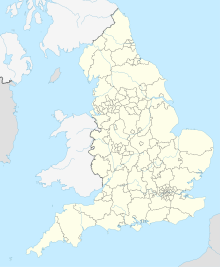This article has multiple issues. Please help improve it or discuss these issues on the talk page. (Learn how and when to remove these messages)
|
 Interior view of the public pit at Grime's Graves | |
| Location | |
|---|---|
| Location | Lynford, Norfolk, England |
| Coordinates | 52°28′33″N 0°40′31″E / 52.47585°N 0.67541°E |
| Production | |
| Products | Flint tools |
| History | |
| Opened | c. 2600 BCE |
| Closed | c. 2300 BCE |
| Owner | |
| Company | Managed by English Heritage |
Grime's Graves is a large Neolithic flint mining complex in Norfolk, England. It lies 8 km (5.0 mi) north east from Brandon, Suffolk in the East of England. It was worked between c. 2600 and c. 2300 BCE, although production may have continued through the Bronze and Iron Ages and later, owing to the low cost of flint compared with metals. Flint was much in demand for making polished stone axes in the Neolithic period. Much later, when flint had been replaced by metal tools, flint nodules were in demand for other uses, such as for building and as strikers for muskets.
Grime's Graves was first extensively explored by the 19th-century archaeologist William Greenwell.
The scheduled monument[1] extends over an area of some 37 ha (91 acres) and consists of at least 433 shafts dug into the natural chalk to reach seams of flint. The largest shafts are more than 14 m (46 ft) deep and 12 m (39 ft) in diameter at the surface. It has been calculated that more than 2,000 tonnes of chalk had to be removed from the larger shafts, taking 20 men around five months, before stone of sufficient quality was reached. An upper 'topstone' and middle 'wallstone' seam of flint was dug through on the way to the deeper third 'floorstone' seam which most interested the miners. The site is managed by English Heritage and can be visited.
The site is also a biological and geological Site of Special Scientific Interest[2] and a Geological Conservation Review site.[3] It is part of the Breckland Special Area of Conservation[4] and Special Protection Area.[5]
- ^ Historic England. "Grimes Graves, including round barrow in Grimes Graves Plantation (1003619)". National Heritage List for England. Retrieved 1 January 2014.
- ^ "Designated Sites View: Grime's Graves". Sites of Special Scientific Interest. Natural England. Retrieved 16 May 2018.
- ^ "Grime's Graves (Quaternary of East Anglia)". Geological Conservation Review. Joint Nature Conservation Committee. Retrieved 25 May 2018.
- ^ "Designated Sites View: Breckland". Special Areas of Conservation. Natural England. Retrieved 25 May 2018.
- ^ "Designated Sites View: Breckland". Special Protection Areas. Natural England. Retrieved 25 May 2018.
